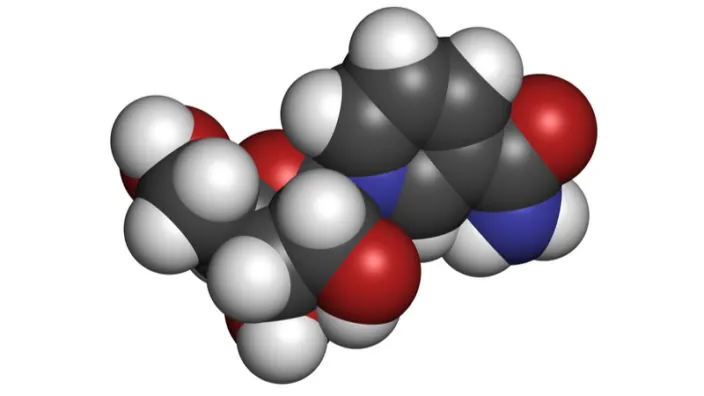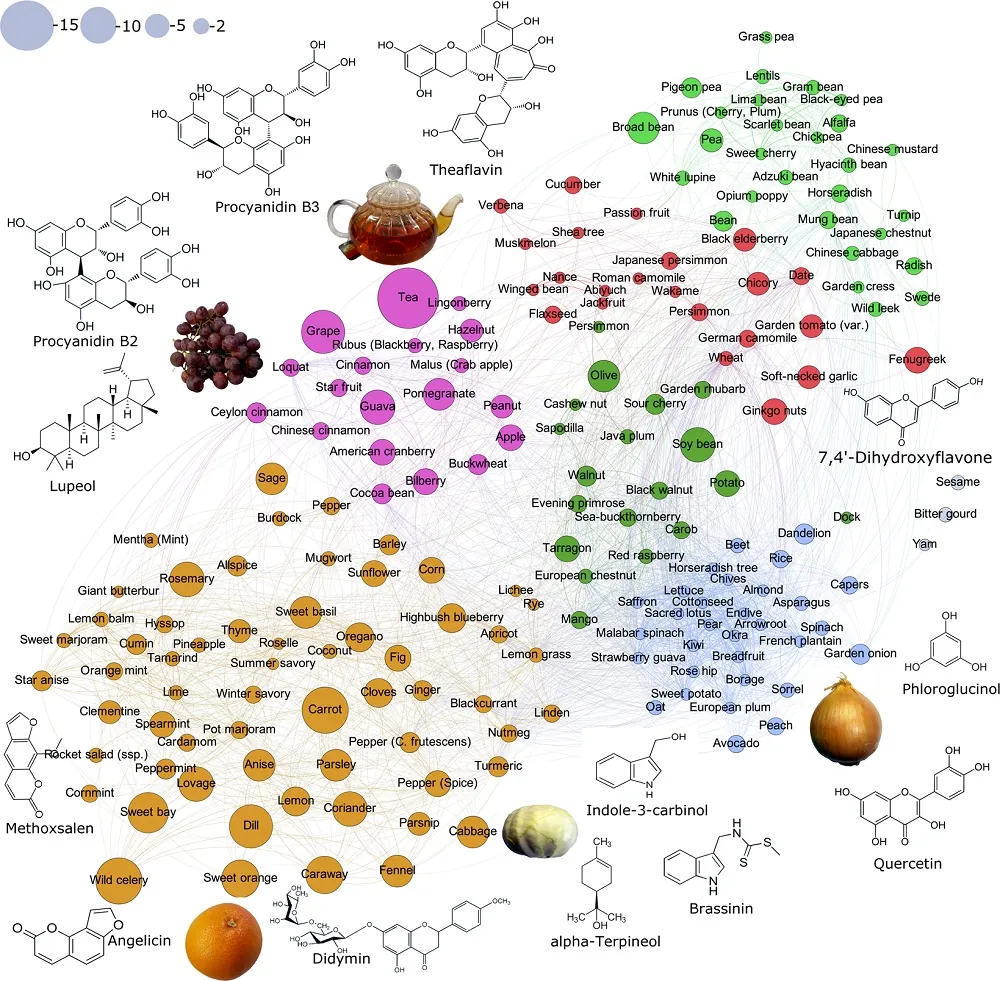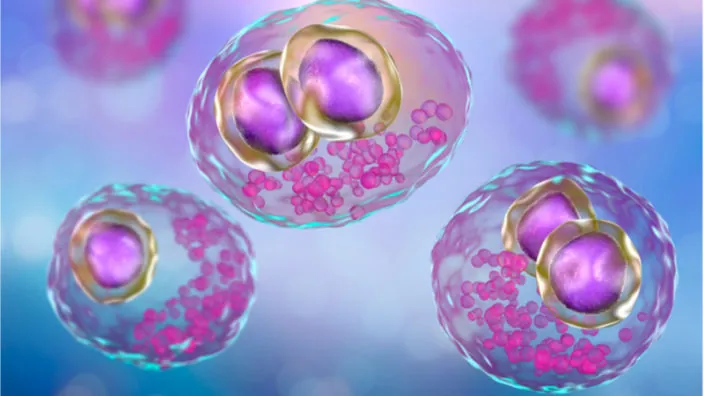We had the opportunity to interview one of the speakers, Dr. María Blasco, during the conference, and we asked her more about her work with telomeres, telomerase therapy, and aging.
Telomere loss is a proposed reason we age
Telomere attrition—the wearing out of your chromosomes’ protective caps with age—is widely thought to be one of the major drivers of aging. With each division, telomeres shorten a little bit, and after 50-70 divisions, they become critically short. Once this threshold (the Hayflick limit) is hit, cells undergo replicative senescence, and their division comes to a grinding halt.
This limitation would quickly lead all cell lines to extinction if stem cells—the progenitors of each cell—didn’t express the enzyme telomerase, which allows them to replenish their telomeres and give rise to subsequent generations of new cells to replace dying ones.
Short telomeres have long been linked to age-related pathologies as well as to a number of other diseases not related to aging. Conversely, telomerase expression— and thus telomere elongation—where it’s not supposed to happen is what drives most human cancers. For these reasons, this field of research has been very active over the past few decades, and today, we’d like you to meet one of its big names.
A telomere pioneer
Dr. Blasco is a molecular biologist whose primary interests, since her university days, have been cancer and aging. After completing her Ph.D. at the Center of Molecular Biology in Madrid under the supervision of Professor Margarita Salas, she moved to Cold Spring Harbor, New York to work as a postdoc researcher in the lab of Dr. Carol Greider—the same Carol Greider who co-discovered telomerase with Elizabeth Blackburn in 1995. At the time, the link between cancer, aging, and telomerase was a mere hypothesis yet to be proven, and Blasco set to out clone the murine telomerase gene and generate telomerase-knockout mice [1] in order to study the effects that the lack of the enzyme would cause in the animals [2].
That same year, Dr. Blasco returned to Spain, her home country, where she started her own research group at the Centro Nacional de Biotecnología (National Biotechnology Centre) in Madrid. Eventually, she was recruited as the Head of the Telomeres and Telomerase Group at the Spanish CNIO—the National Center for Oncological Research. In addition to this position, which she still retains, she was also appointed Director of CNIO’s Molecular Oncology Program, then Vice-Director of Basic Research, and since 2011, she has been the CNIO Director. Additionally, she sits on the Scientific Advisory Board of the SENS Research Foundation together with many other luminaries in the field of aging research.
Dr. Blasco is also one of the co-authors of the well-known publication The Hallmarks of Aging [3], which was published in 2013 in the journal Cell, one of the most cited papers in biogerontology. This paper showed the essential lack of any meaningful biological distinction between “aging itself” and the pathologies of aging, and it reinvigorated the idea that a maintenance approach against aging may be the way to go.
She also co-authored the book Morir joven, a los 140: El papel de los telómeros en el envejecimiento y la historia de cómo trabajan los científicos para conseguir que vivamos más y mejor. (“Die young at 140: The role of telomeres in aging and the story of how scientists work to get us to live longer and better”)
Driving telomere research forward
The link between cancer, aging, and telomeres has always been the main target of Dr. Blasco’s laboratory. She and her team showed that telomere loss contributes to degenerative pathologies and that increased telomere fragility leads to higher cancer risk [4].
Other studies at her lab clarified the effect of telomerase activity and telomere length on the regenerative capacity of adult stem cells [5]; showed that the longest telomeres are a general feature of adult stem cell compartments and suggested that telomere loss may contribute to stem cell dysfunction with age [6]; found that cancer-resistant mice that overexpress telomerase experience delayed aging and have longer median lifespans [7]; and showed how DNA damage limits reprogramming of defective cells [8].
More recently, Dr. Blasco and her team developed a new model mouse for idiopathic pulmonary fibrosis that more accurately emulates the human disease and demonstrated that telomerase therapy reverses it [9].
What draws you to aging research over studying other fields?
For me, the aging research field is the most fascinating because aging is underlying the majority of diseases that are killing us today in developed countries: cancer, neurodegenerative diseases, lung, kidney, liver fibrosis, all this is the consequence of aging. So, understanding aging may be the way to one day be able to prevent or cure these diseases.
You and your team recently published a study showing that it is the rate of telomere shortening that predicts the lifespan of a species rather than the total length of telomeres. Does this discovery confirm the role of telomere attrition as a primary cause of aging rather than a consequence?
I think this study that means that telomeres are important in determining a species’ longevity. It’s not something that happens only in humans, where it’s already clear that in humans, telomere length matters, because there are humans that have mutations in telomerase, and they are going to have diseases associated with telomere shortening, which means that telomere shortening rates are very limiting for humans.
We didn’t know whether this was general to other species or only something particular to humans. In this study, we see that telomeres seem to matter across evolution in different species, from birds to mammals. It’s not the telomere length that matters but the rate of telomere shortening. So, we see that the rate of telomere shortening actually fits into a power law [regression] curve, and this predicts the longevity of a given species.
The study compared the telomeres of mice, goats, dolphins, gulls, reindeer, vultures, flamingos, elephants and humans, and it shows that species in which telomeres shorten faster live shorter lives. Could it mean that telomere shortening rate could be a suitable aging biomarker to test interventions against aging with?
I think so; telomere shortening rate is important in humans in order to determine if anyone is at risk of prematurely developing diseases associated with short telomeres. It’s not as important to measure telomeres once, because this probably is not going to be very informative, but the rate at which telomeres shorten may be more informative of the risk of developing any disease related to short telomeres.
The study also suggests that it is the rate at which telomeres shorten rather than the length that could be important. However, other studies show that telomeres form loops when they’re long enough, and they silence various age-associated genes and contribute to genomic stability through the telomere position effect (TPE). How does this reconcile with the idea that rate and not length is important in aging?
I think that this is a good point, but we already knew for instance that mice have very long telomeres and, still, they live very short lives, like two or three years. So this was already telling us that the length of the telomeres is not what is important to determine longevity; actually, later on, we found that the rate of telomere shortening of mice is like 1000 times faster than in humans. That’s where we had the idea of looking at other species and seeing whether there was any conservation of this idea that the rate of telomere shortening determines longevity.
So even though TPE may have an important role, it seems that throughout evolution, the rate of telomere shortening has been adjusted to determine lifespan, at least in the species that we included in the study. Of course, we should look at more species and see whether they still fit into this power law curve that we found.
Could negative effects from telomere shortening be related also to the release of shelterin proteins, since older humans do not have critically short telomeres across all tissues and cells?
It is a very interesting question. I think it will be worth looking at shelterins, because we have previously found and published that shelterin levels also go down with aging, and so it would be interesting to see what happens with shelterin proteins in different species. That would be a very interesting study.
Telomerase has many effects that are independent of telomeres. Can you see that they matter in aging?
Well, it is interesting because we have, in the past, demonstrated that we can extend the lifespan of mice by using telomerase, but it must be wild-type telomerase; if we use catalytically dead telomerase, then we don’t see this lifespan extension. So I would say that in order to see effects of telomerase in lifespan, you need it to be catalytically active telomerase, and this is the canonical pathway of telomerase, which is elongating the telomeres. At least in our hands, this is the mechanism by which telomerase can increase longevity: by extending short telomeres.
Some people suggest that mouse telomeres could work differently from humans because they are longer. So, what works in mice might not work the same in humans. Would you say that the telomere mechanisms and the dynamics are really that different between mice and people?
I think humans among mice are not that different. What is very different is the rate at which mice experience shortening telomeres, or in other words, mice are much worse than humans, at maintaining their telomeres. So, I think this makes a difference. So mice shorten their telomeres really fast, we still don’t understand why compared to humans, but now we also know that different species shorten their telomeres at different rates, and I think it’s very interesting to study that. We don’t know why. For example, the elephant and the flamingo have the same rate of telomere shortening and they have similar longevity; why is that? Then a mouse has a much faster rate of telomere shortening and a shorter longevity. I think this is a very interesting question to solve in the future.
Progeric mice are often criticized as not being representative of true aging and that if you perturb an aging hallmark as is done in these mice, then repairing that damage will, of course, increase their lifespan. What are your thoughts on using progeric mice strains as a way to inform the direction we take in aging research; are they still a useful model in that sense?
In general, I agree that a very fast model of aging may not represent physiological aging. In the case of telomeres, we know that also wild-type mice also suffer telomere shortening with aging, and I think this is a good model. Telomere shortening is something physiological that we and mice suffer, and it’s underlying aging and age-related diseases, so it’s a good model. A telomerase-deficient mouse, for instance, reflects a physiological process, which is telomere shortening associated with aging. I agree that if, for instance, you remove one shelterin, this causes very rapid aging, but I don’t think this is as physiological as telomerase deficiency, where we see something that we know is important for human aging.
Have you observed any change to the typical causes of death in the mice that have been treated with telomerase therapy?
At the end, the mice die of the same diseases. It’s that we are delaying the onset of these diseases which means we are delaying aging; aging is the cause of these diseases, and so if we delay aging, we delay the onset of these diseases. But, in the end, the mice die of the same diseases.
The goal is to translate telomerase therapies to mice that are not genetically modified to age faster, so the therapy can be tested against normal aging. Can you tell us about your experiences with telomerase therapy on normal-aging mice, and does this give us grounds for optimism in translating this therapy to humans?
Yes, actually the first experiment that we did was in normally aging mice. In this experiment that we did with telomerase gene therapy, we used wild-type mice, normal mice, and then treated them with telomerase, and we saw that we could delay aging and age-related diseases in normal mice. This was the first paper that we published in 2012 in EMBO Molecular Medicine.
Now, we are using mouse models for human diseases. We had to reproduce in mice pulmonary fibrosis associated with short telomeres, aplastic anaemia, because these are diseases that, in humans, originate due to short telomeres. So, we wanted to have mouse models in order to be able to try therapies, and the therapy that we have tried to use, of course, is telomerase activation, because the thing we are working on in my lab, mostly as a way to delay aging, is to activate telomerase.
In December 2016, Belmonte and his team successfully used OSKM partial cellular reprogramming in living mice to increase lifespan [10]. You and your team also published another example of OSKM induction in living animals published in January 2017 [11]. OSKM appears to rescue telomeres and restore their length. Some researchers also suggest that resetting telomeres can also reset the epigenetic alterations in the cell, as these two hallmarks are linked via TPE-OLD and other mechanisms. Do you think we need to target both telomere attrition and epigenetic changes in the cell, or can you get an effect by resetting one?
I think it is clear that when you reprogram and you go from a differentiated cell that has short telomeres to a pluripotent cell, an undifferentiated cell made by induced pluripotency, you are really changing everything. You are elongating the telomeres, activating telomerase, and changing the epigenetics. So, we are doing everything. This reprogramming is really able to reset telomeres to a pluripotent state, which is much longer, et cetera. So, it’s a way to start over.
Of course, using reprogramming right now, even though it showed some benefits in mice, has some concerns as well, because programming is something that cancer can use. Dedifferentiation of cells can produce teratomas.
The 2018 paper “Therapeutic effects of telomerase in mice with pulmonary fibrosis induced by damage to the lungs and short telomeres” [12] showed that telomerase therapy reverses the condition. How closely does this new fibrosis mouse model resemble the actual disease compared to older models, and does efficacy in this model mean that it can translate to human trials?
I think this model is a good model for the human pulmonary fibrosis associated with short telomeres; there may be other types of fibrosis that are not associated with short telomeres, but if a human has pulmonary fibrosis associated with short telomeres, then I think this is a good model, because these mice have short telomeres that per se cannot lead to fibrosis, but if you combine it with a low dose of a damaging agent to the lung, then they develop fibrosis. So, it’s a good model to combine short telomeres with the damaging agent to the lung, and this may be quite similar to what happens in humans, where short telomeres may synergize with smoking, pollution, or radiation.
What are the main challenges that telomerase therapy faces on the road to human use, and do you think we might see it reach humans in the next decade or so if all goes well?
I think it’s very likely that we will see telomerase activation for the treatment of telomere syndromes. These are diseases that are associated with mutations in telomerase, and the patients that have these diseases have no therapeutic options or very few. So I think there is likely that we will see telomerase activation therapies reaching clinical trials. This is my hope.
We have shown already in mouse models that telomerase activation can have therapeutic effects, slowing down the progression of diseases or even curing the disease. I think a logical step would be to go through clinical trials to see whether there is a clinical benefit in the treatment of these patients.
We would like to ask you a small favor. We are a non-profit foundation, and unlike some other organizations, we have no shareholders and no products to sell you. All our news and educational content is free for everyone to read, but it does mean that we rely on the help of people like you. Every contribution, no matter if it’s big or small, supports independent journalism and sustains our future.
Literature
[1] Blasco, M. A., Funk, W., Villeponteau, B., & Greider, C. W. (1995). Functional characterization and developmental regulation of mouse telomerase RNA. SCIENCE-NEW YORK THEN WASHINGTON-, 1267-1267.
[2] Blasco, M. A., Lee, H. W., Hande, M. P., Samper, E., Lansdorp, P. M., DePinho, R. A., & Greider, C. W. (1997). Telomere shortening and tumor formation by mouse cells lacking telomerase RNA. Cell, 91(1), 25-34.
[3] López-Otín, C., Blasco, M. A., Partridge, L., Serrano, M., & Kroemer, G. (2013). The hallmarks of aging. Cell, 153(6), 1194-1217.
[4] Martínez, P., Thanasoula, M., Muñoz, P., Liao, C., Tejera, A., McNees, C., … & Blasco, M. A. (2009). Increased telomere fragility and fusions resulting from TRF1 deficiency lead to degenerative pathologies and increased cancer in mice. Genes & development, 23(17), 2060-2075.
[5] Benetti, R., García-Cao, M., & Blasco, M. A. (2007). Telomere length regulates the epigenetic status of mammalian telomeres and subtelomeres. Nature genetics, 39(2), 243-250.
[6] Flores, I., Canela, A., Vera, E., Tejera, A., Cotsarelis, G., & Blasco, M. A. (2008). The longest telomeres: a general signature of adult stem cell compartments. Genes & development, 22(5), 654-667.
[7] Tomás-Loba, A., Flores, I., Fernández-Marcos, P. J., Cayuela, M. L., Maraver, A., Tejera, A., … & Viña, J. (2008). Telomerase reverse transcriptase delays aging in cancer-resistant mice. Cell, 135(4), 609-622.
[8] Marión, R. M., Strati, K., Li, H., Murga, M., Blanco, R., Ortega, S., … & Blasco, M. A. (2009). A p53-mediated DNA damage response limits reprogramming to ensure iPS cell genomic integrity. Nature, 460(7259), 1149-1153.
[9] Povedano, J. M., Martinez, P., Serrano, R., Tejera, Á., Gómez-López, G., Bobadilla, M., … & Blasco, M. A. (2018). Therapeutic effects of telomerase in mice with pulmonary fibrosis induced by damage to the lungs and short telomeres. Elife, 7, e31299.
[10] Ocampo, A., Reddy, P., Martinez-Redondo, P., Platero-Luengo, A., Hatanaka, F., Hishida, T., … & Araoka, T. (2016). In vivo amelioration of age-associated hallmarks by partial reprogramming. Cell, 167(7), 1719-1733.
[11] Marión, R. M., de Silanes, I. L., Mosteiro, L., Gamache, B., Abad, M., Guerra, C., … & Blasco, M. A. (2017). Common telomere changes during in vivo reprogramming and early stages of tumorigenesis. Stem cell reports, 8(2), 460-475.
[12] Povedano, J. M., Martinez, P., Serrano, R., Tejera, Á., Gómez-López, G., Bobadilla, M., … & Blasco, M. A. (2018). Therapeutic effects of telomerase in mice with pulmonary fibrosis induced by damage to the lungs and short telomeres. eLife, 7, e31299.


















